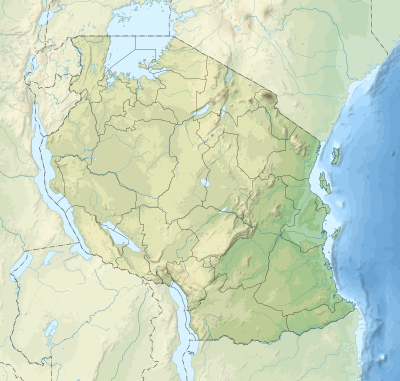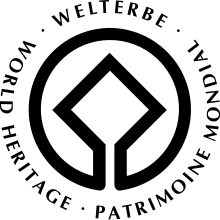Kondoa Rock-Art Sites
The Kondoa Irangi Rock Paintings are a series of ancient paintings on rockshelter walls in central Tanzania. The Kondoa region was declared a UNESCO World Heritage site in 2006 because of its impressive collection of rock art.[1] These sites were named national monuments in 1937 by the Tanzania Antiquities Department.[2] Some of the paintings are believed by the Tanzania Antiquities Department to date back more than 50,000 years, though the paintings are generally dated at 2,000 years old.[1] The paintings depict elongated people, animals, and hunting scenes. Older paintings are generally red and associated with hunter-gatherers, but they are often superimposed by the more recent 'late white' paintings of agro-pastoralists.[2] These paintings span the Middle Stone Age (MSA) to the beginning of the Later Stone Age (LSA), making it a good collection for the purpose of studying culture changes during this transition.[3]
| UNESCO World Heritage Site | |
|---|---|
 Close-up view | |
| Location | Kondoa District, Tanzania |
| Criteria | Cultural: (iii), (vi) |
| Reference | 1183rev |
| Inscription | 2006 (30th session) |
| Area | 233,600 ha (577,000 acres) |
| Coordinates | 4°43′28″S 35°50′02″E |
 Location of Kondoa Rock-Art Sites in Tanzania | |
The landscape of this area is characterized by large piled granite boulders that make up the western rim of the Maasai steppe and form rockshelters facing away from prevailing winds.[4] These rock shelters are where the paintings are found, relatively protected from weathering. Today the decorated rockshelters are used by the local Irangi people for spiritual purposes, including the regular sacrificing of animals during healing ceremonies.[2] The persisting significance and use of the rockshelters suggests that there has been a cultural continuum among the people who have resided in the area over time.[3]
The paintings are located approximately nine kilometres east of the main highway (T5) from Dodoma to Babati, about 20 km north of Kondoa town, in Kondoa District of Dodoma Region, Tanzania. The boundaries of the site are marked by concrete posts.[3]
“Africa’s rock art is the common heritage of all Africans, but it is more than that. It is the common heritage of humanity." -President Nelson Mandela[1]
Sites
There are many individual sites within the UNESCO World Heritage boundaries. The following are some of the most important, notable, or otherwise well-excavated. The exact number of rock art sites in the Kondoa area is currently uncertain. However, estimates for the number of decorated rockshelters in the region range between 150 and 450.[3]
Kisese II Rockshelter
The Kisese II Rockshelter is part of the UNESCO World Heritage site located in the Kondoa region of Tanzania. The site contains transitional assemblages from the Middle to Later Stone Age.[5] The rockshelter has preserved diverse paintings, beads, lithics, pottery, and other artifacts. It is studied for its insight into the major social transitions that were taking place during the late Pleistocene and Holocene eras.[6] The site was also used for the burial of seven Holocene individuals.[5] There are not very many well-dated sites that span this transitionary period, so Kisese II excavations have been very informative. The significant number of ostrich eggshell beads were used for radiocarbon dating of the site, the oldest of which dates to 46.2–42.7 ka cal BP.[5]
The Kisese II Rockshelter began to be excavated by Mary and Louis Leakey in 1935, and Raymond Inskeep expanded the excavation trench in 1956.[5] Inskeep uncovered the large collection of ostrich eggshell (OES) beads that allowed for later radiocarbon dating of the site, in addition to almost 6,000 lithic artifacts in situ.[7] The stratigraphic nature of the depositions were also studied by both Inskeep and the Leakeys in an attempt to date the site.
The lithic artifacts at Kisese II range from flakes to cores, mostly made of local quartz-based stone, and mostly made by using the Levallois method or the LSA microlith method.[5] The site supports the idea that some MSA technologies, such as this method of making stone tools, persisted well into the LSA. Tryon et al proposed that the transitionary period may have been a minimum of five to ten thousand years.[5]
Mungomi wa Kolo (Kolo 1 site)
Mungomi wa Kolo is the local title for the site known as Kolo 1.[1] The art in this rockshelter is mostly composed of fine-line red ochre drawings depicting various people and animals.
The Paintings
Nash's discoveries
In 1929, T. A. M. Nash published an overview of some red ochre paintings he discovered near Kondoa-Irangi.[8] Nash recognized the granite shelters to be an ideal place for rock art and consequently scoured the hill-side for drawings- proving himself correct after about ten minutes. One of the paintings depicts a human figure holding a stick and an elephant. Nash commented on the peaceful posture of the human, doubting that the drawing was intended to depict a hunting scene. Other paintings portray giraffes, a possible rhinoceros fragment, a humanoid figure composed of concentric circles in the head and continuous lines from the top of the head to the rest of the body, and some other figures whose intended depictions were unclear.[8]
Ethics in archaeology
Due to the spiritual significance that many of these rock shelters hold to the contemporary inhabitants in the area, great care must be taken when excavating these sites. According to the UNESCO World Heritage papers 13, the local agro-pastoral Irangi people still use some of these sites for ritual healing purposes.[2] Some of these ritual practices are said to threaten the integrity of the paintings, such as the practice of throwing melted animal fat.[3] The Tanzanian government has yet to recognize the local belief systems, so there exists a friction regarding management and conservation of the sites. This is not an isolated problem; decolonization of African archaeology as a whole is an ongoing project.[2]
References
- Coulson, David; Borona, Gloria K. (2013). Rock Art of Konda Irangi and Other Attractions. TARA (Trust for African Rock Art). ISBN 978-9966-7453-4-7.
- Netherlands National Commission for UNESCO (2004). World Heritage Papers 13. Paris, France: UNESCO World Heritage Centre. pp. 82–83.
- UNESCO.org
- Nash, T. A. M. (1929). "Note on the Discovery of Some Rock-Paintings Near Kondoa Irangi in Tanganyika Territory". The Journal of the Royal Anthropological Institute of Great Britain and Ireland. 59: 199–206. doi:10.2307/2843565. ISSN 0307-3114. JSTOR 2843565.
- Tryon, Christian A.; Lewis, Jason E.; Ranhorn, Kathryn L.; Kwekason, Amandus; Alex, Bridget; Laird, Myra F.; Marean, Curtis W.; Niespolo, Elizabeth; Nivens, Joelle; Mabulla, Audax Z. P. (2018-02-28). Petraglia, Michael D. (ed.). "Middle and Later Stone Age chronology of Kisese II rockshelter (UNESCO World Heritage Kondoa Rock-Art Sites), Tanzania". PLOS ONE. 13 (2): e0192029. Bibcode:2018PLoSO..1392029T. doi:10.1371/journal.pone.0192029. ISSN 1932-6203. PMC 5830042. PMID 29489827.
- "From the Field: Jason Lewis". The Leakey Foundation. Retrieved 2019-10-22.
- Inskeep, R. R. (1962). The age of the Kondoa rock paintings in the light of recent excavations at Kisese II rock shelter. Musée royal de l'Afrique centrale. OCLC 57938032.
- Nash, T. A. M. (1929). "Note on the Discovery of Some Rock-Paintings Near Kondoa Irangi in Tanganyika Territory". The Journal of the Royal Anthropological Institute of Great Britain and Ireland. 59: 199–206. doi:10.2307/2843565. ISSN 0307-3114. JSTOR 2843565.
See also
Further reading
- UNESCO.org World Heritage Tentative List
- Leakey, Mary D. (July 1983). "Tanzania's Stone Age Art". National Geographic. Vol. 164 no. 1. pp. 84–99. ISSN 0027-9358. OCLC 643483454.
